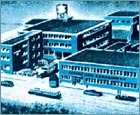
The Gilbert Spruance Company was a manufacturer of industrial coatings, primarily wood finishes, for the furniture and kitchen cabinet industries. Headquartered in Philadelphia, Spruance had been at one time a viable and very competitive manufacturer, with sales of $7 million in 1986. I was the last remaining family member in the company (we spanned three generations).
In the late 1970s, I tried to implement culture changes in the company reflecting the new wave of business leadership and management principles enunciated by authors such as Tom Peters, Robert Waterman, and Peter Drucker. I sought to instill team building, spur research and development, and break down “hierarchical walls and boundaries.” We embarked upon a program to establish good, solid environmental practices. We realized that we needed to take a proactive position with respect to our wastes and our recycling efforts and to work with customers both to establish safe and competitive products and to institute processes that were environmentally and enduser friendly. We also began developing coatings that minimized air pollutants.
But the business plan fell apart because our capital resources were drained by Superfund. Most of the capital accumulated from profits during and after 1984 went to our legal defense and to compliance-driven regulatory environmental directives.
In 1984, our waste hauler, Marvin Jonas, testified before the EPA that he had hauled waste for Hercules, DuPont, the Columbia Broadcasting Company, Texaco, Chrysler, and Spruance, among others, to sites that had become Superfund sites. Jonas’s incriminating testimony (offered, we were told, under implied immunity) put Spruance in a defensive position-our guilt was already assumed.
Under Superfund, joint and several liability means that companies can be held accountable and responsible for the cleanup of an entire waste site, even if their contribution was only a fraction of the total. Furthermore, actions that were legal at the time they took place are now viewed as criminal.
So, if you used a hauler and your waste was found in a site, you were a potentially responsible party (PRP). A pizza parlor might have contributed waste in a Superfund site as small and as insignificant as an old pizza box. The glue holding the pizza box together may have had formaldehyde and toluol. Since these ingredients are considered toxic, the pizza parlor could be held liable for the total cleanup of the site.
Ultimately, Spruance was involved with eleven Superfund sites. Our contributions to these sites, based on Jonas’ records, were all under 1 percent (and Spruance’s own records never substantiated any of our wastes going to any of the Superfund sites). At one site in New Jersey, our waste contribution was figured to be .023 percent, yet we were sued for a de minimus (minor) settlement of $150,000 to get the first phase completed, and future liability remained open-ended. Another suit demanded that we pay as much as $1.3 million.
The Superfund process is a game where large companies whose resources are better positioned to withstand the legal liabilities can take advantage of small companies. Once Spruance was notified that we were a potentially responsible party for a site, we were asked to be part of a liaison council. The liaison council was supposed to get all PRPs to agree on a cleanup plan. At the Lipari site in New Jersey, Rohm and Haas, a large chemical manufacturer, was deemed to be the largest contributor; Spruance was considered a de minimus contributor.
The liaison council could not come to an agreement on how much the de minimus contributors should pay. Rohm and Haas then sued us for $200,000 ($180,000 for cleanup and an additional $20,000 in liaison council fees). Spruance was sued for an additional $150,000 six years later, and the litigation over Lipari is still going on.
In 1986, our insurance company, the Pennsylvania Manufacturers Association, won a declaratory judgment in Pennsylvania allowing it to neither defend nor indemnify Spruance at any New Jersey site. And the word Superfund seemed to send lenders running for cover. In 1989 Spruance’s building and land were appraised at $1.1 million. By the middle of 1990, this appraisal was discounted by our bank to zero. We were then told our inventory of petrochemical-based raw materials could not be used for collateral. These were perfectly good raw materials, but anything that had a chemical derivative was deemed to be a potential liability. Environmental hysteria resulted in our loan being called.
After losing our insurance coverage, we spent over $300,000 in legal fees alone and had nothing to show for the effort. In 1990, I offered to put what Spruance was spending on legal bills toward site cleanup. But this proposal, which seemed to make good business sense for all concerned, was not accepted.
I finally fired all the lawyers and took my story to Washington. I found out that no one really wanted the company; all they wanted was my money.
At Spruance we just did not have the resources to cope with the wave of regulatory suits. In addition, the media seemed to delight in reporting on how companies and people were being fined, and some people even went to jail for environmental violations. This fear created chaos and made us at Spruance feel as though the whole process was hopeless. The stress became huge and it was impossible to focus on our core business of making wood finishes for the marketplace.
In the end, I sold what was left of the company to someone who wanted a bargain-basement price and was “bottom fishing.” The transaction proceeded smoothly, but my anger and frustration with the process are as vivid as that August day when the corpse of my company was buried.
Robert M. Cox, Jr., is the author of EPA and Superfund: A Small Business Story (Alexandria, VA: Washington House, 2002). He can be reached at
superfundbob@fc-partners.com.


